#for maximum usability
Text

DETERMINATION
decided to start coloring some manga panels as a way to practice working with color, so here's the first of many. this is from trigun maximum vol 1 ch 5, genuinely one of my favorite moments
#trigun#trigun manga#trigun maximum#manga panel coloring#vash the stampede#my art#this one's very simple but i plan on getting more detailed with practice#color is definitely one of my weaknesses so we're starting slow lol#figuring out how to clean up the panel to be usable as lineart was honestly most of the battle here#hopefully now that i've got a system going i'll have more energy when i get to the actual coloring part
117 notes
·
View notes
Text
trying to make generator VE-20B functional let alone useful is going to be the death of me
#okay so like. let me autism about this piece of my mech. gimme a moment.#there is a generator for the mech that gives you like absolute maximum Energy Firearm Spec#what this means is that it makes your energy based guns (sadly not melee) do great damage and charge up faster#however. it has pretty poor energy capacity#and you need good en capacity to USE energy weapons#because every weapon and piece of the mech. uses energy.#i'm desperately trying to make it usable with the KRSV (to my knowledge the most over the top insanely powerful energy weapon)#but what this is leading to#is a goddamn WILD GOOSE CHASE all over my mech desperately trying to optimise it within an inch of its life#all for this one thing#that i DON'T EVEN THINK WILL BE WORTH IT#compared to running like quad laser shotguns#but i've aaaalmost got it working#my big issue. my white whale. is i want FOUR energy weapons#which i thiiiink i can do... the other ones will suck but i THINK i can do it#dibi#armored core
43 notes
·
View notes
Text
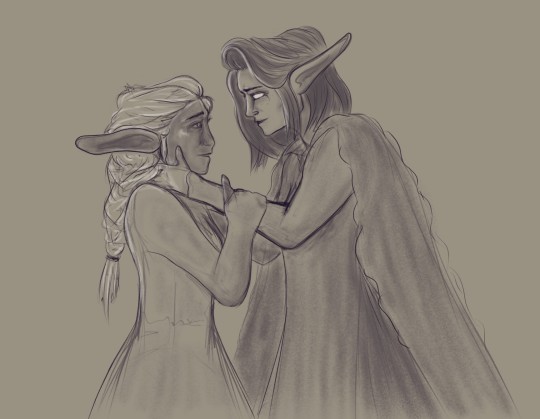
[Ruin by The Amazing Devil playing softly in the background]
showed up to this d&d game to deal AOE psychic damage to every member of the party and then mySELF
#alt title: photos taken moments before cyclical inevitable tragedy.#(it's fine she's just cursed she'll get better.)#ivy is not in fact smol for the record. she's like 5'9 lol. amana is just six and a half feet 😌 benefits of being archfey: height#really just trying to get better at rough sketches that nonetheless look the way I want them to#cuz I am historically BAD at it but if I can wrestle csp into basically working like a charcoal sketch I will be so content#I do love charcoal irl and I find it very usable but man. why do I only like art mediums that are MESSY.#no I absolutely did NOT do all of the turkey tail mushrooms on Amana's cloak or the lichen dress texture. see aforementioned practice goal.#also very funny that this happened a day after my friends were over and yelling at me like 'THERE'S SOMETHING GOING ON THERE'#while I was Knife Cat about it#(there is indeed something going on there and it is VERY sweet and designed for maximum resulting pain)#ANYWAY sure hope nothing happens to my little amnesiac charge! sure would be a shame if I had to go feral to protect her!!!#surely my DM would NEVER (he absolutely would and I encourage it I am an unkillable glass cannon and I want to fight like it)#dnd oc#my art
15 notes
·
View notes
Note
Knowing other adults have twin sized beds makes me so happy. Everyone I know acts like I'm crazy for wanting one but
The floor space!!!
THE FLOOR SPACE!!!!
I do not know what I'd do without floor space I love having Floor Time and i think more people should participate. Adult humans are severely lacking in Floor Time!
#ezra gets a letter#someone better at interior design could probably figure out a waybto get Maximum Floor with a full sized bed#but like. who has the time.#also bed MUST be against a wall and i really only have the one usable corner lol
8 notes
·
View notes
Text
Ham Radio: A Personal Account
by Kevin Gillette
Amateur radio, or ham radio as it is more commonly known, has been a hobby for millions of people around the world for approximately 100 years, give or take. It exists today for much the same reason it came about in the first place: it is (and was) a way for both amateur and professional engineers, tinkerers, physicists and inventors to interact with one another, comparing notes, ideas and innovations that have played a major role in the expansion of telecommunications up to the present day.
This brief memoir is not a history of the hobby, for I came into it only 50 years ago, in 1974. As a result, I don’t have first-hand knowledge of most of what came before. But I can sketch the essentials for you, and with any luck, I will persuade you to see how this hobby can bring a great deal of joy and satisfaction. At the end of this account I will provide some tangible evidence of my days at the helm of a transmitter/receiver/antenna combination over the course of several decades.
First, some preliminaries:
Ham radio began about 100 years ago. The very first enthusiasts used very primitive equipment for both transmission and reception. The earliest transmitters used a technique called spark gap in which the radio signal arose from a spark generated between two electrodes. The frequency of this transmission was dictated by the physics of the electrodes and the gap between them.
For frequency, think of your standard AM and FM broadcast bands, or local television. Radio emission occurs when an electrical field rapidly reverses direction – that is, electrons flow back and forth through a wire or some other device capable of supporting an electromagnetic field. The speed with which this flow of electrons reverses course determines the frequency; the faster the course reversal, the higher the frequency. A single round trip of the electrons is usually referred to as a cycle. Thus, frequency is expressed in cycles per second, or in an equivalent unit, Hertz (one Hertz = one cycle per second). All electromagnetic radiation can be expressed this way. Radiation typically occurs when the flow of electrons alternates direction - electron flow goes by the term current, and so radiation happens with alternating current, or AC. In many (though not all) countries, the electricity that comes out of a wall plug is AC. The opposite of AC is DC - direct current - and this is the case when the electrons always flow the same direction. In essence, DC is zero Hertz AC.
The range of hearing of most humans is between about 60 Hertz (Hz) and roughly 10,000 Hz (this is also indicated as 10 kiloHertz, or 10 KHz). In the United States, the AM broadcast band is from 540 KHz to 1600 KHz (this latter measurement is also expressed as 1.6 megaHertz, or 1.6 MHz). Standard television signals have traditionally begun at 54 MHz, which each television channel occupying a total of 6 MHz. So this means that Channel 2 (for obscure reasons, there is no Channel 1) is from 54 – 60 MHz, channel 3 from 60 – 66 MHz, and so on. There is a break in this pattern for the U.S. FM broadcast band, which lives from 88.0 – 108.0 MHz; the TV channels then continue up to channel 13. The channels 2 through 13 are called the VHF - Very High Frequency - channels. After channel 13 there is another significant frequency gap, after which the UHF, or Ultra High Frequency channels begin, with channel 14.
I’ve mentioned a couple of undefined terms: AM and FM. AM stands for Amplitude Modulation. This was the earliest method used for transmitting sound signals (voice, music, etc). It works by using a central frequency known as the carrier and superimposing an audio frequency on it, resulting in the actual size of the emission varying (at the carrier frequency) according to the audio frequency. This methodology gives rise to what are called sidebands, which cover the frequencies between the carrier frequency plus and minus the audio frequency. This is still used today on the AM broadcast bands in most countries. It is rather wasteful in terms of power, since a lot of the transmitted signal power is in the carrier itself rather than the sidebands where all the good stuff is. For this reason, ham radio operators who do voice transmissions have, since about the 1940s or so, used something called SSB, or single sideband transmission. In this mode, one chooses one of the two sidebands (lower or upper) and suppresses the other one as well as the carrier, meaning that most of the transmitted power goes into the information in the signal rather than being wasted. A more recent form of transmission is FM - Frequency Modulation. In FM transmission, instead of varying the amplitude of the carrier wave as a function of the audio content, the frequency wiggles according to the superimposed audio content. In AM transmission, static and other interference phenomena tend to occur at the peaks of the modulation waveform (see the figure below); with FM, the peaks of the waveform don’t contain information so they can be filtered out, and this gives rise to the notion - largely true - that FM is static-free. Here is an example AM waveform as seen on an oscilloscope:

For comparison, here is an example of an FM waveform as seen on an oscilloscope:

In this latter picture, notice how the amplitude of the waveform doesn’t change, but the spacing between the cycles does – this is the wiggle in the frequency I referred to earlier.
I mentioned voice operations in ham radio using a technique called SSB. There are other techniques, especially at the higher frequencies, but I’m not going into those here. I admit that I am something of a purist; I have always preferred to use Morse Code in my ham radio exploits. This is known as CW - Continuous Wave - in the ham radio community. The idea is that to transmit Morse Code, one merely turns a carrier – a continuous wave – on and off with a Morse Code key or something equivalent to it. Speed of transmission is usually expressed in words per minute - wpm. Although the requirement is gone today, in the past, obtaining a ham radio license required the operator to demonstrate at least a basic proficiency in Morse Code, usually somewhere between 5 and 20 wpm. A word in this context is a group of 5 characters and the space after them. I’m proud to say that at my peak, I could listen to – “copy” – transmissions running at about 45 wpm. The world record in those days was somewhere in the neighborhood of 75 wpm, and high-speed code operators in the US Navy and elsewhere typically operated at around 50 wpm, so I was competitive in the CW community as far as speed.
I’ve talked a lot about transmission, but of course it’s all for naught if there’s no way to hear the signal. To do this, one needs a receiver. Receivers are generally much more complicated devices than transmitters – even a modern transmitter can often be constructed with perhaps a dozen discrete parts, including the power supply (or batteries), whereas modern receivers typically need about 10 times that amount in order to be effective and reliable. This is because transmitting is essentially an increasing entropy operation from a thermodynamic perspective, whereas receiving is a decreasing entropy operation, which fights against the tendency toward greater entropy according to the 3rd Law of Thermodynamics. This is much the same as it being a lot easier to generate heat than to remove it from an environment. Receivers are far too complicated to get into here, but I will note that for the kind of work I did – CW and Morse Code – the way the signal could be heard was to tune the receiver to a frequency just slightly to one side of the transmitting carrier frequency and use what’s called a BFO - Beat Frequency Oscillator - to provide a sidetone that represents the difference between the BFO frequency and the carrier frequency. This will be important a bit later, so remember that term.
And of course the ensemble isn’t complete without some kind of antenna. Like both transmitters and receivers, antennas can be everything from a simple piece of wire to a very elaborate contraption that covers a lot of real estate. The rule of thumb is that the higher the frequency, the smaller the antenna needs to be. A very common kind of antenna used on the lower ham radio bands is a vertical antenna, which as the name implies, is a piece of metal (usually aluminum) that is vertically installed. The cable that connects the antenna to the transmitter and receiver is usually attached at the bottom of such an antenna – a picture of such an arrangement appears below:

In this photograph, the antenna has some extra horizontal spokes coming off of it at various points – these are used to suppress capacitance effects of the central pole (the fact that it’s a hollow tube and not an infinitely thin wire causes some of these issues to arise) and to otherwise improve the performance of the antenna.
I haven’t said much about power, so I’ll do so now. Where commercial broadcast stations can transmit at quite high power – varying from 1000 watts to upwards of 100,000 watts – ham radio is restricted to a maximum of 1000 watts for CW and 2000 watts for SSB. I was typically a low-power operator, seldom going above 50 watts and often no more than 10 watts. And yet I was able to make contact with people all over the world on such modest power, so it doesn’t take a lot. An effective antenna system and favorable geography are the primary arbiters of how well one can communicate over long distances.
Something else I mentioned but haven’t yet elaborated on is the licensing process. In the United States, there used to be the following levels of licensing, from the most basic to the most advanced: Novice, Technician, General, Advanced, Extra. I began my ham radio career as a Novice, as everyone did in those days. My radio call sign was WN6FEB (see photo below). To obtain a Novice license, one had to know some basic electronic and radio theory, some basic regulatory stuff (power, bands, on-air protocols, etc) and have mastered Morse Code at 5 wpm. I obtained this license when I was 13 years old. A short time later I upgraded to a General class license and a slightly new call sign, WA6FEB, which extended the radio frequency bands I was permitted to operate on and also extended my maximum output power (as a Novice I was restricted to 100 watts, I think). The General class license required knowledge of more advanced electronics and radio physics, a bit more regulations and Morse Code proficiency of 13 wpm. A few years later I took the plunge and got my Extra class license, which expanded the knowledge base from the previous two licenses and required Morse speed of 20 wpm. As an Extra class ham, I had unlimited access to all internationally agreed-upon ham frequency bands and full power rating. My main motivation in getting the Extra class license was the radio bands – I was never a high-power operator.
My Novice license QSL card (more on this in a moment):
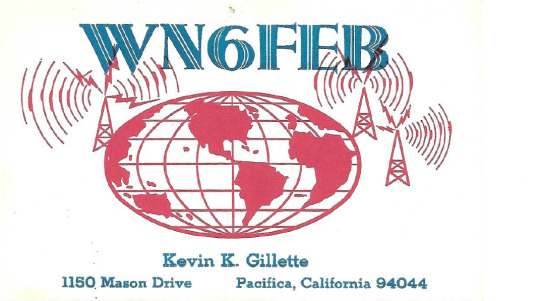
My Extra class license QSL card:
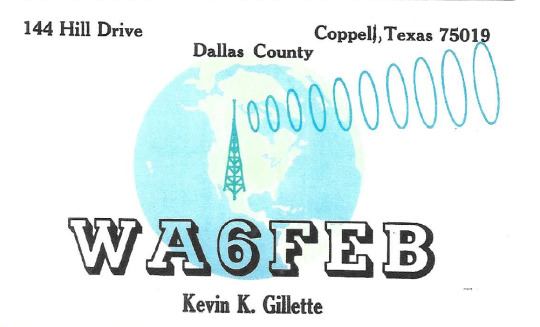
QSL cards are like postcards for hams – we often exchange them to acknowledge that we’ve made contact. They’re often attractive and make great wallpaper or collectibles. I’ve amassed quite a few over the years – there are examples of QSL cards received from around the world at the bottom of this article.
Dovetailing with a previous paragraph, a few words about ham radio frequency bands. Per international agreement, ham radio operators have a large number of radio spectrum segments allocated for their use. It should be noted that in many cases, these allocations are not exclusively for ham radio. One example is the 40-meter band, which covers 7.0 – 7.3 MHz. At least in the 1970s and 1980s, this band featured a lot of non-ham activity, including over-the-horizon radar from the USSR and Voice of America broadcasts from various parts of the world. What made this especially annoying is that the 40-meter band was almost universally open, meaning that effective communication could happen on that band at any time of the day or night, year-round. The Soviet radar sounded like a very loud metronome, and Voice of America was an AM transmission in a segment of the radio spectrum where people didn’t normally use AM, meaning that receivers tuned to this part of the spectrum ended up hearing the carrier as well as the audio signal (which made the audio portion hard to understand). Still, for a young ham radio aficionado hunting for exotic call signs in the ether, it was a lot of fun to wade among the incoherent mass of radio transmissions.
The bands are usually referred to by their approximate wavelength. Recalling that light travels at approximately 300,000,00 meters/second, here is a sample of some of the bands that were popular when I first started back in 1974 (there have been additional bands added to the spectrum since that time; I have no experience on those bands):
HF:
160 meters – 1.8 – 2.0 MHz (I didn’t have any contacts on this band, but my older receiver permitted me to listen in. The antenna requirements for this band are too large for the real estate I had.)
80 meters – 3.5 – 4.0 MHz
40 meters – 7.0 – 7.3 MHz
20 meters – 14.0 – 14.35 MHz
15 meters – 21.0 – 21.45 MHz
10 meters – 28.0 – 29.7 MHz
VHF:
6 meters – 50.0 – 54.0 MHz (note that this is just below the start of the standard television broadcast segment, Channel 2, as noted earlier)
2 meters – 144.0 – 148.0 MHz
I also mentioned the idea of a band being open. On the HF (High Frequency) bands, the propagation of a signal often proceeds in two ways: ground wave and sky wave. Ground wave is exactly as the name implies; the radio signal follows the ground. This signal is of comparatively short distance, perhaps 100 miles or thereabouts. Sky wave is quite a different phenomenon and involves the signal bouncing off of the ionosphere, a layer of our atmosphere that lives between 50 and 600 miles above the Earth’s surface. As the name suggests, this layer contains a lot of ionized particles - mostly from the Sun’s interaction - and it is this layer of ions that forms a sort of reflecting barrier for radio waves below a certain frequency. The highest frequency for which the ionosphere is a reflecting barrier is referred to as the MUF - Maximum Usable Frequency. Above this frequency, radio transmissions pass through the ionosphere and out into space. When a band is open, that means that the MUF is greater than the band’s frequency, at least as an approximation. The 40-meter band is virtually always below the MUF, meaning that it’s open all of the time. This is what makes it so popular. The 20-meter band is often (though not always) open, which is what makes it a premium band for long distance communications, referred to in ham radio parlance as DX (which stands for distance). The 20-meter band has the advantage that it is strictly for ham radio – no competing services cause interference and noise. When an HF band is open, the sky wave mode of signal propagation is also referred to as skip, meaning that the signal will skip off of the ionosphere, sometimes multiple times – this makes for worldwide transmission and reception.
You may be asking yourself what was in it for me, that I would have such fervor for a hobby that is admittedly declining in popularity (with the advent of email and the Internet). I think a simple anecdote will make it clear:
When I was about 15 years old, early in my ham radio career, I lived in a small town near San Francisco and also near Stanford University. I had an on-air friend named David Gray, WB6ZMJ, who was a graduate student in geophysics at Stanford. David was a member of the Stanford Amateur Radio Club (SARC):
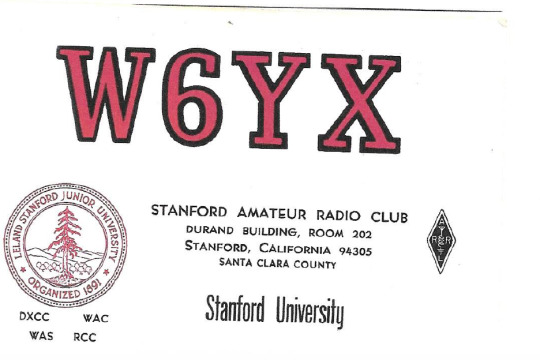
One weekend he invited me down to Stanford to participate in what is known as moonbounce. In moonbounce, hams from across the globe will transmit on the VHF frequencies directly up to the Moon, bouncing their signal off the Moon to be received somewhere else on the planet. Recall what I mentioned above about the MUF; the VHF frequencies are all well above the MUF, so VHF signals cannot participate in the skip mode of propagation (except under some very unusual circumstances). Stanford University has an enormous radio telescope, affectionately referred to as The Dish, that sits on a small hill on the SW side of campus. A picture of it appears below. The Dish is about 150 feet across and was built in 1961. It remains in use to this day. The SARC used The Dish as their antenna for moonbounce activity.
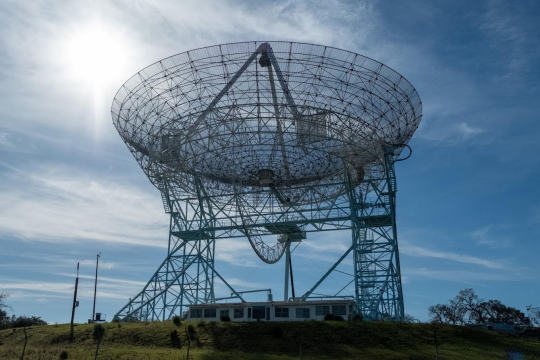
Here's the rub: The path length from Earth – Moon – Earth (EME) is about 500,000 miles. The loss in signal strength approaches 250 dB, which equates to dropping from a Formula 1 roar down to the tiniest of whispers. In fact, the signal strength is so low that even when using CW, the signal isn’t strong enough to trigger a BFO for a sidetone in order to read the signal. The only way to hear the signal is to listen for quiet spots in the background noise! That’s where I came in on this particular occasion. I have (and have always had) exceptionally acute high-frequency hearing, and so what sounded like white noise to the grad students in the SARC was an intelligible signal to me. So, in the middle of the night, there I was, in the metal housing seen at the base of The Dish, listening to a mysterious CW signal from a ham in Sweden coming by way of deep space, and writing down what I heard. For a lonely, nerdy kid, this was the height of affirmation – it was OK to be nerdy and science-oriented when you got to play with such exotic toys! Indeed, not only did this experience cement my desire to pursue ham radio; it also confirmed that Stanford was the place I wanted to pursue my university studies (as indeed I did, graduating with a Bachelor’s degree in applied mathematics and a Master’s degree in operations research, all before my 21st birthday).
In the years following graduation from Stanford, I got married and moved to Dallas, Texas, where once we purchased our first home, I immediately set up a nice ham shack in the laundry room. I made tons of great contacts all over the world with the most modest of equipment (alas, I don’t have any photos of my gear from those days). When we started our family, the hobby had to take a back seat, and eventually I let my license lapse. But now that I am approaching retirement age, I long once more to get back on the air and hunt for those mysterious signals beaming in from everywhere.
Kevin Gillette, 26 January 2024
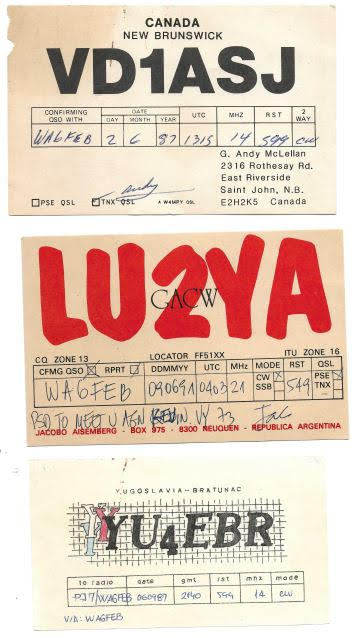
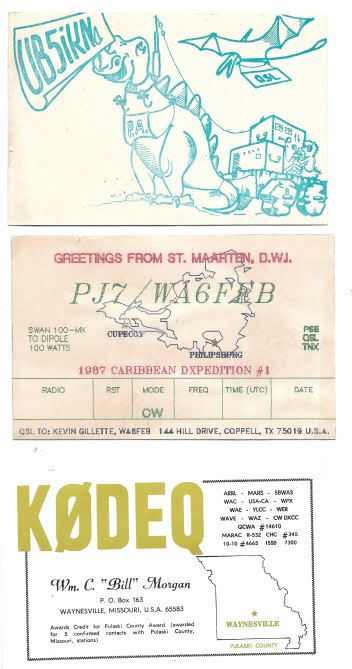



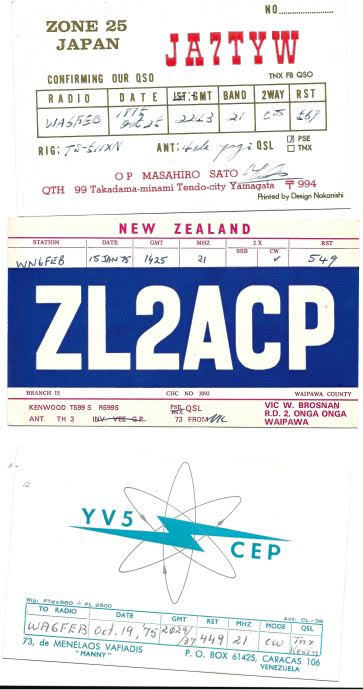

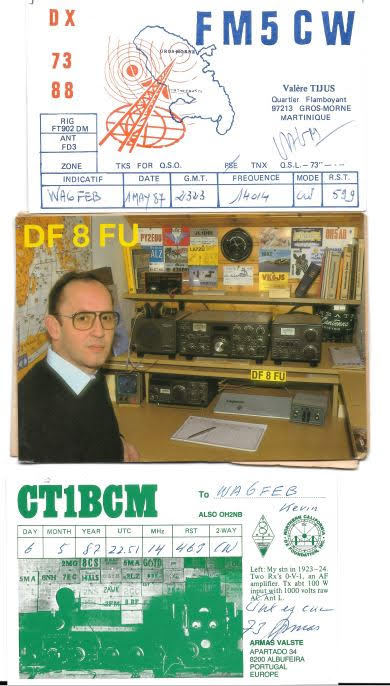

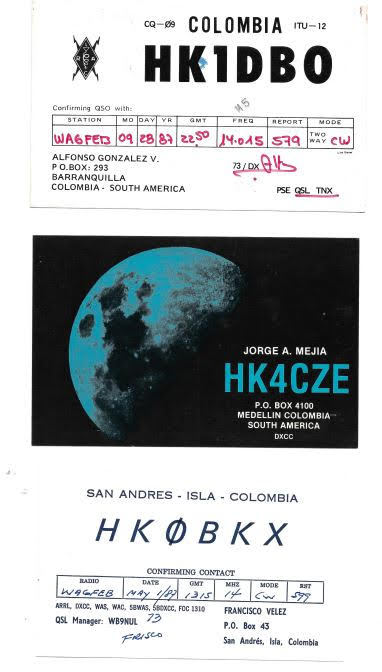
Image credits : Images in the text with thanks to © respective creators and publishers. QSL Cards at end of article above received by author, with thanks to © respective creators
Kevin Gillette
Words Across Time
26 January 2024
wordsacrosstime
#Words Across Time#Kevin Gillette#wordsacrosstime#January 2024#Amateur Radio#Ham Radio#Broadcast Bands#Electromagnetic Field#Stanford Amateur Radio Club#Beat Frequency Oscillator#US Navy#Morse Code#SSB#AM#FM#Maximum Usable Frequency#Sidetone#Sidebands#Continuous Wave#Antenna#Spark Gap#Hobby#Tinkerers#Inventors#Telecommunications#VHF#Frequency Modulation#Amplitude Modulation#Alternating Current#Direct Current
0 notes
Text
in the new dev update (i think its ptb related but i've nyot checked tbh>w>) dbd devs undoing some of the rework of sadako ([reverting how they changed teleports {on sadako's side, nyo mention of the tvs?} and also the tapes got a revert and i THINK she might be getting bloodlust via condenm back? :3] which as someone who still refurs to herself as a former sadako main is HUGE to me :3)
while finding a way to nerf pig (save the best for last getting one of the classic "multi-way nerfs" making it peak effect lesser and makes it so that you can no longer keep stacks by other means of injuring the obsession[like ambushing])
#grim embrace's buff might get nerfed between current and release and either way fucking rip dead man's switch#wld still be a usable perk (given effects like info and a more potent maximum duration) but will deffffo be overshadowed#artist will have had two of the strongest regression perks in the game wadda hell#(had might even be a stretch there pain res is still fucking banger even after its reworking 'nerf')
0 notes
Text
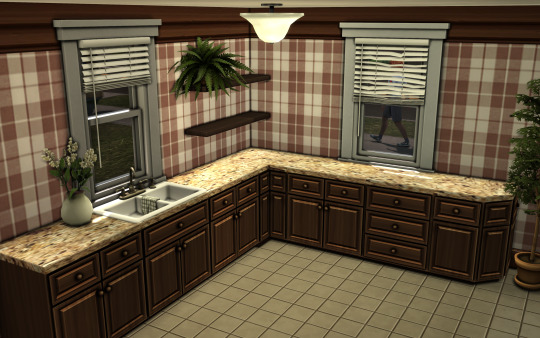


the kitchen cupboards! i've yet to do the uppers and the island, but i really like how they turned out

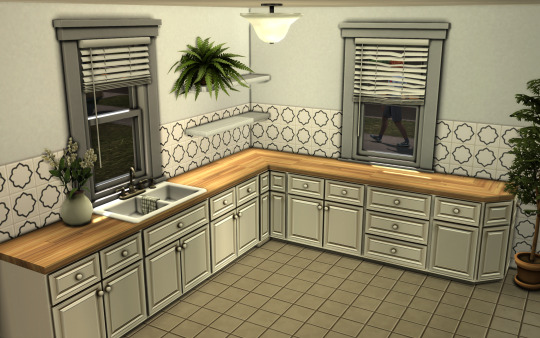

they also come in 'modern' swatches for maximum usability
683 notes
·
View notes
Text
I want people to know how big a deal that kid beating Tetris is.
When we talk about beating games, we usually do so in one of two ways. First, finishing the game. Any%. Getting to the end. Second, completing the game. 100%. Doing everything.
This kid did neither.
Arcade games of the time didnt have a traditional beginning and end. They relied on a score based gameplay loop. "Winning" was losing with the highest score. As such, a traditional final stage or level wasn't necessary because the game was built to loop on itself or speed up continuously until the player inevitably lost.
However, many games still had a hard limit. Either due to a hardware limitations or inconcevable corner cases in a game's code that would force it to crash. Pacman's final state is quite famous. At 255 completed levels, the game would load in a corrupted and incompletable level know only as the Kill Screen.
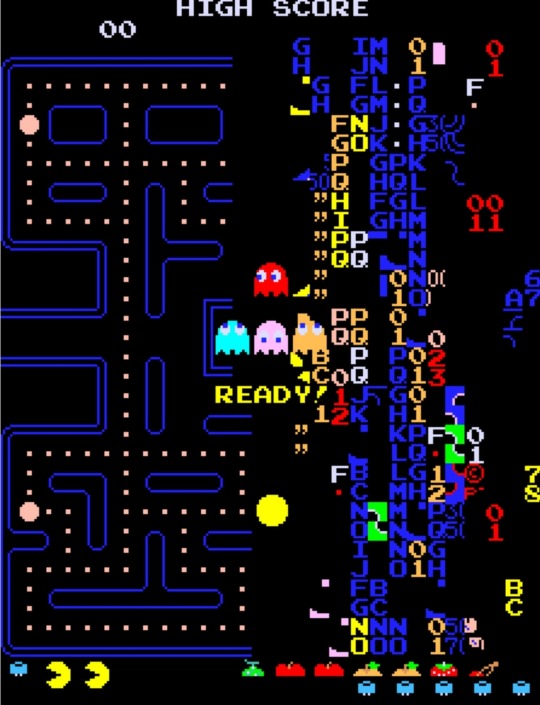
The abridged reason for why this happens is that the high level count causes too many fruit to be drawn on screen. Which results in the fruit being drawn over other data, corrupting it and rendering the level incompletable.
Few of these are reached and only by the most dedicated players.
But why the hype around Tetris specifically?
Well, it was believed for a long time that Tetris' kill screen had already been found.
On the NES version of Tetris, when you hold the left or right buttons on the d-pad, the falling tetris piece will only move every few frames. This produces a maximum speed that Tetris pieces can be moved to either the far left or right side of the screen

As you play Tetris and clear lines, the game speeds up. At 290 cleared lines, the tetris pieces would fall so fast they simply could not be moved fast enough across the screen to be usable.
This was believed to be the end of the game. No human could go much further than around level 29. The original kill screen.
Then, players developed a new technique. Hypertapping. By holding the controller upside down and resting their thumb on the d pad, players would rapidly strike the back of the controller with their free hand to move faster than the default speed. Up to 10 times a second.
This technique saved tetris, and reopened the gates, making new kinds of high scores possible.
Players went on to develop new tools to chase the true kill screen. What they found was an ever changing kill screen. Entirely based on actions leading up to the end. They found what level it occured on would change. Theoretically it would be anywhere between level 155 and 255.
Bear in mind, passing level 29 was thought to be humanly impossible for decades.
Until this kid came along. Not only did he managed to max out the game score, but he managed to become the first person to hit Tetris' absolute kill screen at level 157.
165 notes
·
View notes
Text




Daihatsu Uniform Truck Concept, 2023. A prototype compact electric that sits on the same platform as the Uniform Cargo van and is exactly the same size at 3,395 mm (133.7 inches) long. Like the van it uses minimalist design to create maximum usable space is a compact footprint.
#Daihatsu#Daihatsu Uniform Truck#concept#prototype#electric truck#compact truck#forward control#design study#Tokyo Mobility Show#2023#minimalist design#boxy
297 notes
·
View notes
Text
ઇଓ│ Simphora’s Ultimate Sims 3 Masterlist of Mods │ઇଓ
Hey guys! I receive a ton of questions on the mods I use in my game, so here is my ultimate masterlist of mods for the Sims 3. All of the mods listed are organized by category. This list will be updated from time to time. Happy Simming!
3/20/24 - Last Updated
(credits to all of the wonderful modders listed below!)

(Keep reading to see the list of mods).
εϊз NRAAS Mods
These mods are essential!
NRAAS Master Controller: This mod adds countless options that allow you to easily control and change just about anything about Sims in your town. Featuring a robust filter system to allow you to find the Sims you want to target and execute actions on.
NRAAS Master Controller Cheats (module): This mod is an optional module of Master Controller and includes the more advanced; therefore "cheaty" aspects of Master Controller. (Must have the base-mod installed for this module to work properly).
NRAAS Master Controller Integration (module): This mod is an optional module of Master Controller and replaces all the CAS interactions in the game with the one managed by Master Controller, including the "Create-A-Sim" button in "Edit Town". (Must have the base-mod installed for this module to work properly).
NRAAS Career: This mod is used to load custom careers into the game. It is also possible to load custom book lists, custom skills, and standing social interactions.
NRAAS Careers School: This mod contains a series of high-school "trade" school careers.
NRAAS Debug Enabler: This mod exposes EA debug commands so that it is usable in game. It also adds a few useful commands to fix common problems.
NRAAS Error Trap: This is a core-mod intended to catch and correct data corruption errors that can render a save-game unloadable. Any corruption errors that can not be corrected will be trapped and logged, allowing the save-game to load regardless.
NRAAS Go Here: This mod replaces the "Go Here" interaction, with one that can be stacked in the queue, allowing the user to better direct the route of a sim. It also makes inactive Sims less likely to go home, restores haunting ghosts in the grave yard, fixes common routing errors and adds a robust set of door locking features.
NRAAS Mover: This mod removes the "greater than eight" and "requires adult" restrictions in "Edit Town" and the Phone and Computer "Move" interactions. It also retains the dreams and opportunities of Sims when switching households.
NRAAS Overwatch: The primary purpose of this mod is to act as a periodic clean up system for correcting errors and eliminating junk that accumulates over a regular play-session.
NRAAS Portrait Panel: This mod changes the Portrait Panel to display a maximum of 24 Sim portraits, useful for playing overstuffed families.
NRAAS Porter: This mod adds a custom version of the import and export system used to create Library families. With this, it is possible to transfer entire towns worth of sims, preserving relationships across households, and reducing the amount of manual intervention required afterward.
NRAAS Relativity: This mod can be tuned to change the speed at which time flows during the course of a sim-day.
NRAAS Relationship Panel: This mod changes the Relationship Panel. Changes have also been made to correct the "red box" relationship error that occurs when the window bounces while displaying certain types of sims.
NRAAS Register: This mod alters the rules governing role assignment in the game, allowing sims to maintain regular careers without losing their roles. In addition, it provides the ability to select which sim you want to perform specific roles in town.
NRAAS Returner: This mod provides the ability to alter which interactions are autonomous and/or user-directed via an in-game interface, both ITUN and SocialData based.
NRAAS Saver: This mod prompts the user to save after a given amount of play-time.
NRAAS Story Progression: This mod is a non-core story progression replacement. The EA story progression will be disabled by this mod, and a new, hopefully better, system is started in its place.
NRAAS Story Progression Money (module): This module contains the expanded money scenarios for use with Story Progression. (Must have the base-mod installed for this module to work properly).
NRAAS Sims Drinks: This mod adds custom moodlets to the game when your Sims have drinks to simulate them being drunk.
NRAAS Tempest: This mod provides a more detailed approach to controlling weather on a town-by-town basis, providing the ability to adjust weather profiles on an daily basis during any particular season.
NRAAS Woohooer: This mod alters the romantic game systems allowing for more relaxed rules when compared to EA's. It also allows for teen woohoo and pregnancy along with risky woohoo.
NRAAS Woohooer Toilet Stall (module): This module for Woohooer integrates the toilet stalls, adding support for Woohoo interactions. (Must have the base-mod installed for this module to work properly).
NRAAS Woohooer KamaSimtra (module): This is a custom skill to facilitate tracking of woohooing. It provides a series of optional challenges that can be completed for improved post woohoo moodlets. (Must have the base-mod installed for this module to work properly).
εϊз CAS & Genetics Mods
These are mods that affect Create-A-Sim and the Sims genetics.
CAS Zoom In + Pets: This mod allows the camera in CAS to zoom in closer, including pets.
CAS Room Recolored: A custom/recolored CAS background instead of the original one.
Pearly Whites Default Teeth: A realistic default teeth replacement.
Stand Still in CAS: This mod gives Sims more of a gender-neutral, natural-looking, standstill animation in CAS.
Sliders: This mod realistically enhances Sims facial and body features in CAS.
Teen Neck Edit: This mod allows Teen males to wear Adult male clothing without a neck glitch.
εϊз Environment Mods
These are mods that affect the environment.
BrntWaffles Frozen Lighting Mod: A default replacement lighting mod that overrides the lighting in all worlds. It makes the environment look so much prettier, and not dark or gloomy.
Realistic Clouds: More realistic and improved clouds. This mod is compatible with all lightning mods.
Snow But Better: An override filled with textures to make your game more frosty looking and even more realistic if you're into those sorts of things!
No Full moon Lighting Effect Mod: This mod completely removes the special, hardcoded "full moon" lighting effect in Supernatural - a green glow with added bloom. The full moon lighting is now just like any other night, both indoors and outdoors.
Improved Environmental Shadows: This mod enhances the shadows in-game.
εϊз Gameplay Mods
These are mods to help enhance gameplay.
Better Greets: This mod aims to solve that and expand upon the possibilities by making Sims’ greetings also take into account things like personality traits, social group and relationship status.
Cigarette Smoking Mod: This mod allows Sims to smoke/purchase cigarettes and nicotine gum.
Deep Conversations Mod: This mod gives you some insight on what your Sims are talking about and often lets you choose what your sim will say, which may affect their relationship positively or negatively.
Hospital Overhaul Mod: This mod improves upon the hospitals by adding more features to it, such as abortion, donation services, in-vitro fertilization & alien implantation, sex reassignment, sterilization, surrogacy, ultrasound scanning, and veterinary services.
More Complex Recipes: This mod makes existing recipes more complex by changing or adding ingredients.
No Fridge Shopping: This mod replaces the meal-making interactions on the fridge with custom ones that check whether the Sim has the required ingredients to make the meal or snack.
NPC Romance: This mod attempts to breathe some life into your Sims’ NPC friends and romantic interests by allowing them a chance to advance their relationship with your Sims.
Online Center: This mod adds a set of new interactions to computers and smartphones, such as eShopping, reading eBooks, checking the PlumbBook.
Retuned Attraction System: This mod revises a bunch of the parameters that control the attraction system; changing it to be more selective in-game.
Sim State: This mod focuses on adding ownable stores to the game. (LINK DELETED)
Taxi Charge: This mod will charge sims for Taxi rides.
Violence and Aggression: This mod adds a list of violence social interactions.
εϊз Gameplay Fix Mods
These are mods to help fix any gameplay errors/mistakes from EA.
The Smooth Patch 2.0: This mod alters the speed at which the game's processing runs, which improves the overall performance of the game and some loading times. Most noticeably in Create- A-Sim, Create-A-Style and Buy/Build.
Thumbnail Camera Edits: This mod contains some edits to the INI files that control the camera positioning the game uses for generating thumbnails.
Random Sim Fixes: This mod attempts to fix issues with and improve randomly generated and aging up Sims (such as pudding face) in a non-intrusive, non-core way.
Route Fix: This mod reduces the amount of time sims will stand around trying to figure out how to get where they are going, checking for obstacles, and waiting on other sims to move before going around them.
Shimrod’s Autonomy Fixer: This mod makes the autonomy run more frequently, such that auto-Sims will not stand around as long before deciding what to do next, they choose the next action quicker.
No (or fewer) Automatic Memories: This mod stops the memory scrapbook from filling up with useless memories that then have to be manually deleted to make room for custom memories or to keep save files small.
No Social Groups: This mod disables all Social Group Influence gain and removes any existing Influence from all Sims.
No Mutant Hair or Eyes: This mod forces all newborn sims to have their parents' or (if they exist) grandparents' eye and hair color. There is no chance of a mutated color being chosen.
All Traits for All Ages: This mod unlocks all visible traits for all ages, baby through elder.
Get To Know Fix: This mod fixes the broken get to know code and enables more discoverable traits.
Spring Cleaning - An Assortment of Vaguely Spring-Related Tweaks: This is a collection of four pure script mods that make a variety of tweaks with the aim of providing a bit more fun and realism to springtime activities.
Spicy Animation Fix: This mod fixes the fire breathing animation error when a sim gets the Spicy or Too Spicy moodlet that forces them into the sitting animation, rather than playing the proper standing animation.
User-Directed Scolding + Other Punishment Tweaks: This mod tweaks parts of the punishment system from Generations. It will warn you with a pop-up whenever the game tries to force a sim to scold a misbehaving child/teen so you can stop them if you wish.
Higher Quality Headline Effects: A default replacement for headline effects. It is more clean and sharp, graphic wise!
Home Video Camera Fix: This mod changes the speed of the home video from Generations to a slower, more efficient speed.
University Life Visual Fixes: This mod includes fixes for a few visual mess-ups EA made with University Life.
No Camera Fade: No fade in camera view or first person.
Less Or No Laundry On The Floor: This mod can either reduce the amount of laundry piles that appear on the floor in a 24 hour period once a Sim gets changed to complete a particular task, or can eliminate laundry piles appearing on the floor forever.
Faster Gardening: This mod reduces the time needed for weeding, watering and harvesting plants, and therefore makes gardening much faster.
Pigtails Glitch fix: This is a core mod that fixes the infamous 'pigtails glitch' caused by CC hairstyles.
Pick up Toddler fix: This mod does in detail, is a simple fix that now sims will always route to the toddler to pick them up no matter where they are, while the toddler waits and stays in place. They can also pick up them up at whichever angle, which doesn't always look the best but I've also replaced the animations so the transition between the toddler sitting on the floor and being picked up is smoother.
εϊз Pregnancy Mods
These are mods that affect pregnancies in the game.
Mixed Feelings About Pregnancy: This mod allows pregnant sims to express feelings about their pregnancy.
More Pregnancy Interactions: This mod adds new social interactions between pregnant sims and sims of all ages. Another part is an overhaul of the pregnancy announcement interaction.
More Seasons Interactions For Pregnant Sims: This mod enables various seasonal interactions for pregnant sims.
Pregnancy Controller: This mod adds a set of pie menu Pregnancy Options to all sims teen and above, both human and pet. This mod consists of a bunch of functions like, ending or pausing pregnancy, start labor, set chance of multiples, set pregnancy progress, and set the sex. (OUTDATED)
εϊз Baby & Toddler-Children Mods
These mods impact babies and toddlers in the game.
No Stretch Children Can Series: These mods convert adult motion to child one. Children can use objects with no stretch.
Blush Baby: A default skin blend for babies. (LINK DELETED)
Beetle Eyes: Accessory contacts for babies.
Little Baby Wisps: Little hair wisps for babies that will show the baby’s real hair color at birth.
Sleeper Footies: Babies are now born with cute onesies and legs. No more burrito babies!
Better Playdates: This mod allows toddler-children to have playdates.
Breastfeeding Mod: This mod adds a breastfeeding interaction to the game.
White Formula Default Replacement Bottle: This mod replaces the green milk bottle with a white milk bottle.
Biggest Little Mod For Toddlers: This mod enhances the gameplay of a toddler.
More Toddler Interactions: This mod adds new interactions for toddlers, so now you can do a lot more with them, such as bathing them, talking to them, literally tossing them in the air and more.
More Play, Playmat: An interaction where babies can actually play on the mat.
Toddler Food and Snacks: This mod adds two interactions to the high chair to feed toddlers meals or snacks.
Toddlers Extra Activities: This mod allows Toddlers to do extra activities.
Toddler Foods and Snacks: This mod adds two interactions to the high chair to feed toddlers meals or snacks. There are 11 meals and 5 snacks. Similar to Growing Together, toddlers will love, like or hate certain foods.
Toddlers Can Learn To Walk Alone: In this mod, toddlers will finally be able to learn to walk by themselves, no adults or store walker required!
Toddlers Can Sit With Sims: This mod allows toddlers spend even more quality time with their parents and/or siblings!
Functional Baby Carrier: An actual functional baby carrier inspired from the Sims 4 Growing Together Expansion Pack.
Tooth Fairy Mod: This mod gives child-aged sims the chance to lose their teeth and get money from the Tooth Fairy.
εϊз Pet Mods
These are mods for pets.
Pet Diseases: This mod introduces four diseases (or five, depending on how you count). All can be caught by cats or dogs and are contagious between the two species.
Pet Bowl Requires Food: Instead of watching your money disappear into thin air when you fill the pet bowl, now watch your money disappear into the grocery store void (or your supermarket owner’s pockets, if you please).
εϊз Miscellaneous Mods
Extra mods, not essential to have at all.
Build/Buy Catalog Search: This mod simply adds a search button to Buy and Build mode.
One More Slot Please: This mod allows you to place objects anywhere in your sims house.
Facial Expressions Converted From The Sims Medieval: This is a replacement mod that swaps out The Sims 3's facial idle animations with their The Sims Medieval equivalents, plus some additional tweaks.
Clean UI: This mod changes the UI color from Blue to White.
705 notes
·
View notes
Text
FIRST COURSE - KNIVES
(or at least the ones I recognised from the TV-show so far)

mads mikkelsen by kenneth willardt for vanity fair italy, 2015 - aka my favorite shoot of his.
i apologize.
1. Spyderco Harpy
• appears in Hannibal season 3 in Italy .ೃ࿐
The Harpy was designed as a knife for seamen, featuring a karambit style blade that magically cuts right through rope, the serration lending a hand to the task.
Additionally, the Harpy boasts a detailed tip, which can chew through a manner of different materials, probably one of the main reasons why Hannibal found it handy for different...matters. To sum it up: This is not one of his kitchen knives, but rather one he used as a pocket knife in all different kind of situations.
Originally the japanese Spyderco Harpy was designed to accommodate the needs of commercial fishermen. The hawksbill blade is modeled after the talon of the Harpy eagle, allowing for a deliberate pulling cut where the object does not slip off the end of the edge. The hollow-ground blade incorporates SpyderEdge serrations and a thick spine for support. The handle is made of stainless steel with a drying vent, perfect for Hannibal and his exquisite taste…and of course correspondingly expensive. A good 200 euros for this fine tool, everybody. But he seems to be rolling in money, so no problem for our favourite cannibal.



2. Chroma Type 301 style by F. A. Porsche
• appear in various episodes as Hannibal’s kitchen knives .ೃ࿐
To be honest I really fell in love with the Spyderco Harpy and didn’t quite think anything could change that. But. When I tell you the design…omg. The Chroma Type 301 knife series was brought to life by F.A. Porsche (yup, the german car guy) and the chef of the decade, Jörg Wörther (austrian chef).
Japanese knives have achieved global recognition for their quality, as the Japanese hold a long tradition in metallurgy. The Japanese metallurgists have elevated the forging and sharpening of the blade into a form of art for hundreds of years, since the era of the notorious Katana swords. On the other hand, Europeans and Americans also make excellent knives, often characterized by superior ergonomics and design, but rarely distinguished for the hardness and sharpness of their blade.
The type 301 knife series by Chroma bridges the gap between Japanese tradition and the European design, this series standing out for its unique design and practical function. Porsche and Wörther closely worked together in order to develop the final shape of the handle, which is optimized for maximum usability. The result is a precision cutting tool. Each knife is carefully weighted to ensure perfect balance in the hand and in combination with the highly ergonomic handle, it feels like an extension of the user’s hand. The Chroma type 301 knives follow faithfully the Japanese philosophy, which dictates a knife to be lightweight and flexible. They are made of high-quality Japanese 301 steel, a relatively lightweight material which has a 56-58 hardness rating in the Rockwell hardness scale. This renders the type 301 knives harder than most of the non-Japanese knives and among the hardest knives within their price range. The increased hardness allows the knife to maintain its sharpness longer and also to slice better.Even though the Chroma type 301 knives are mass produced, they are carefully razorsharp sharpened by the hand of a master. Quality control is performed on one-to-one basis and not through random sampling. And by the way…did I mention the extraordinary design.

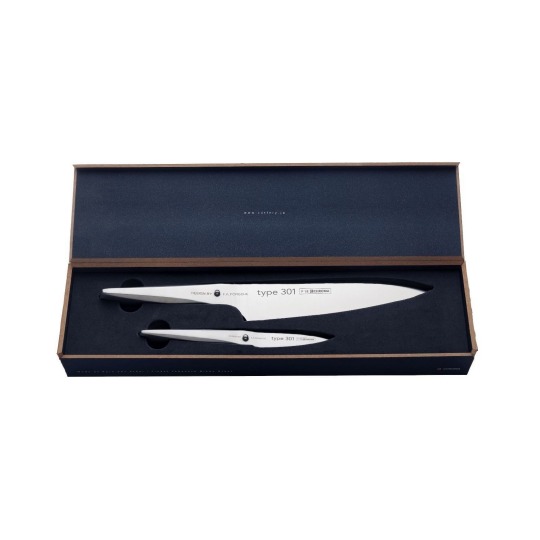
3. Kai Shun Knives
• appear in various episodes as Hannibal’s kitchen knives .ೃ࿐
Before Shun Cutlery was established in the western market, most people were used to heavy European-style kitchen knives. With Shun’s entry into the marketplace, home cooks and professional chefs alike were introduced to the lightweight precision of fine Japanese cutlery. Thinner blades, sharper edges, and lighter weight gave Shun a high-performance edge that the heavier knives couldn’t match. Each Shun still takes at least 100 handcrafted steps to complete and Shun remains true to its ancient heritage of quality. At the same time, Shun takes advantage of thoroughly modern, premium materials and state-of-the-art technology to provide that traditional quality to millions of professional chefs and avid home cooks throughout the world.
Today, Shun has become one of the most well-known names in kitchen cutlery. It has won awards for innovation and quality. It has been admired and emulated. With new styles, new materials, and an ongoing dedication to the spirit of innovation, Shun will continue to provide Japanese kitchen cutlery of outstanding beauty, impeccable precision, and the very highest performance.



4. Global Knives
• appear in various episodes as Hannibal’s kitchen knives .ೃ࿐
Global G Series knives are typically put together in what's called a three piece construction. The blade is stamped out of sheets of steel of a proprietary stainless steel alloy, while the two handles are created and welded together separately. The blade and handle are then welded together into one solid piece of stainless steel.
What makes these Global knives a bit unusual is that they start off empty. The blades are welded on without a tang and the handles are actually hollow. Instead, to maintain balance, they are filled with a very precise amount of sand.
Now it's quite unusual and you might just write this off as Japan being Japan and doing things differently because...well, they're Japan, but it seems to work very well for them.
The ability to inject a precise amount of weight (sand, in this case) as needed directly into the knife has led to them getting a reputation or having very precise and excellently balanced knives across their range of products.
That said, ergonomics are always personal.
Global G Series knives tend to feel very lightweight and evenly balanced. Some people tend to prefer a knife that is more weighted to the back for a firmer grip, or to the front for chopping action. This is the classic global knife version, but of course there are various other series one can discover. Unfortunately I am not able to tell the exact version Hannibal uses in the show by just watching...if anyone has an idea let me know!!!
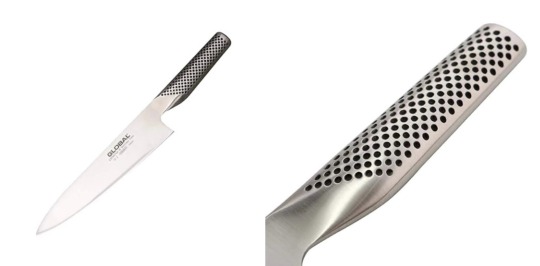
#hannibal lecter#hannibal#hanniballecter#hannigram#mads mikkelsen#mads#food#michelin#cooking#kitchen knives#old money#aesthetic#eat the rich#eat the rude#fannibal#will graham#fyp#fypツ#fypシ#vintage#chef#cheflife#Spotify#yeehaw peepaw#peepaw#fashion#fannibals
35 notes
·
View notes
Text
Cursed Item
You've heard of a harmonica? This is the Healonica. Only usable by bards, this becomes your absolute favorite instrument once you start to use it - you'd never perform with anything else. To identification spells or casual observation, the Healonica appears to improve a bard's performance skill checks and restore their injuries slowly over time. This second part is slightly true - the only benefit of the item is to give the user a constant 5 temporary hit points. If these are lost or more than 5 temporary hit points are gained, the Healonica restores the total to 5 after one minute.
Unfortunately, this benevolent item hates to see violence. In combat, any time an enemy falls below half their maximum hit points, as well as each time you use your bardic performance abilities, the Healonica plays a flourish, restoring 2d8+5 hit points to three creatures within 60 feet. It has a tendency to choose enemies of its user, but will heal allies to get to a total of three, if necessary.
39 notes
·
View notes
Text
WHAT IS THE BIG FREEZE??
Blog#286
Saturday, April 8th, 2023
Welcome back,
The Big Freeze, which is also known as the Heat Death, is one of the possible scenarios predicted by scientists in which the Universe may end. It is a direct consequence of an ever expanding universe. The most telling evidences, such as those that indicate an increasing rate of expansion in regions farthest from us, support this theory.

As such, it is the most widely accepted model pertaining to our universe’s ultimate fate.
The term Heat Death comes from the idea that, in an isolated system (the Universe being a very big example), the entropy will continuously increase until it reaches a maximum value. The moment that happens, heat in the system will be evenly distributed, allowing no room for usable energy (or heat) to exist – hence the term ‘heat death’.

That means, mechanical motion within the system will no longer be possible.
This kind of ending is a stark contrast to what other scientists believe will be the Universe’s alternative ultimate fate, known as the Big Crunch. The Big Crunch, if it does happen, will be characterized by a collapse of unimaginably gargantuan proportions and will eventually culminate into an immensely massive black hole.

The Big Freeze, on the other hand, will happen with less fanfare since everything will wind down to a cold silent halt.

To determine which ending is most possible, scientists need to gather data regarding the density, composition, and even the shape of the Universe.

For example, if the density is found to be lower than what is known as the critical density, then a continuous expansion will ensue. If the density is equal to the critical density, then the Universe will expand forever but at a decreasing rate.
Finally, if the density is found to be greater than the critical density, the Universe will eventually stop expanding and then collapse.
It is therefore clear that, for a Big Freeze to occur, the density must be less than the critical density.
Originally published on universetoday.com
COMING UP!!
(Wednesday, April 12th, 2023)
"CAN GRAVITY CREATE LIGHT??"
#astronomy#outer space#alternate universe#astrophysics#spacecraft#universe#white universe#parallel universe#space#astrophotography
94 notes
·
View notes
Text
The warmth is overwhelming (my body burns almost as if they're cremating it)
It's very hot in the VALORANT HQ, specially in summer. See, this can be a problem to agents who are used to the cold, like Sova or Breach, but that's why there's a rule that says that you can indeed go around shirtless and with short pants.
No agent is allowed to have their personal AC, they only have one on their common room. For bedrooms they use fans, but an AC has never been given to anyone, not even Brimstone.
Now here comes the problem. Phoenix's body tends to be hot, like burning hot, but in summer it gets worse. Between his own body heat and the outside heat he literally feels like dying, and that makes even Viper have some sympathy for the guy.
Brimstone's already recieved complains from Phoenix, Jett and Viper herself about this. "Let that kid have a goddamn AC," she said, "I don't want to find him sleeping in the fridge again, I nearly had a heart attack that time."
They also have rules for the common room's AC. One of the rule used to be that there had to be more than three agents in the room to use it, but it was later modified to that plus not being usable in the night, because Phoenix managed to convince Jett and Sova to go sleep there so he could get colder. The other rule is that the AC must be 77°F (25°C) at minimum, and 82.4°F (28°C) at maximum.
Today is different, as it is around 122°F (50°C) outside and everyone is worried about their fire boy, mostly because he looks both tired and about to melt from the heat.
"You really need to get something cold, mate, not even the common room AC is helping." Skye says, handing him a handful of ice and cringing when it almost immediately melts in his hand.
Phoenix has only the shortest pants known to man on, and he's still sweating even under the AC. Skye, who's also wearing short pants but has a sports bra on, is trying to help him get a bit colder, but everything she's tried hasn't worked.
"What's going on?" Killjoy asks when she gets in the room, looking at the two of them almost as if they were crazy.
"I'm trying to help Phoenix cool down! I've tried everything!!" The other woman says with desperation in her voice, "I've tried handing him ice, it melts. I've tried feeding him ice, it doesn't melt but doesn't work either. I've tried sticking cold stuff in his body, doesn't work. We've tried Harbor's waves, they don't work either. He's under the AC. We're considering removing everything from the fridge and getting him in there again."
"Why can't you put the AC colder?" Killjoy asks, then looks at the AC controller, "Oh wait, it's at the minimum, right?" She asks, to which Phoenix can only nod.
"That rule is stupid." Reyna says as she steps in the room, "You're going to die if we keep it like this, necesitamos hablar con Brimstone!" She exclaims, looking at Phoenix with full pity in her eyes.
"I'll talk with him," Sage says, already heading to Brimstone's office, "he is in no condition of doing anything, not even existing at this point." Before she gets out the room, she hears Skye scream and quickly turns around. Phoenix has passed out from the heat.
"I've already told you, we can't do that." Brimstone states, looking at the three women before him, "If we give it to him, the rest are going to ask for one."
"It's not like they're little kids, Brim," Reyna says, looking at him at the eyes almost as if he was her pray, "I'm pretty sure they'll understand."
"We can't have him do anything in this condition, do you understand how dangerous that is for a human being?" Sage asks, then continues before giving the man time to answer, "It's so critical, I don't doubt he could die because of it at this point."
"Okay, okay, fine," Brimstone says, standing up, "I'll talk with-"
"No, Brimstone, you'll get him the fucking AC because he can't even speak." Viper says, looking at him with dangerous eyes, "Then after that maybe you can speak with him. A body temperature that melts ice cubes as soon as they get close - not even in conact - is more dangerous than you think."
"Alright, then," He says, "but with one condition. You three need to help me choose which AC to take." They all nod and start searching online.
Sova is the first one to notice the giant box on the door of the HQ, left there by the delivery man, probably. He looks at it before calling Brimstone and confirming that it isn't a bomb, then he takes it inside. Sage tells him what it is, and Sova takes it to Phoenix's room, which is currently empty.
After calling Cypher and having Brimstone supervising they both assemble the AC in an hour and a half, then put it in 44.6°F (7°C) and staying in the room until Cypher can't handle the cold. Then they call Phoenix.
He looks like absolute shit, there's no other way to put it. He's sweating, has dark eyebags from not sleeping because of the heat, his hair isn't brushed, and he's leaving burnt marks wherever he steps. Yoru is with him, he was told of this before so he could distract him. Yoru also looks miserable, his hair down and unable to stay up, also has eyebags.
Around a minute after Phoenix steps into the room his eyes widen, looking around for a moment. "Are you feeling this or am I dying?!" He asks, turning to see Yoru, "Dude, it's so cold I might have to put a shirt on!" He jokingly says, smiling wide and looking excited. "Hold on what's happening? Why is it so cold here?"
Yoru smiles at his confusion, then points at the AC set up on a wall. "Brimstone bought this for you, you would've died otherwise." He says, looking at their boss. Phoenix looks at him and smiles widely. Then he stops.
"Wait. You're saying I have my own AC?! For my room?! That I can put in any temperature?!" He asks and Brimstone nods "Ohmygodohmygod finally!!" He exclaims, practically jumping up and down. "Thank you so much, Brimstone!" He smiles even wider (somehow).
"You shouldn't thank me, I only bought it. You should thank Viper, Reyna, Sage, Sova and Cypher instead." He says, smiling. Phoenix doesn't get it but nods anyways, walking around his room.
After two more minutes Brimstone gets out of the room, leaving the other two alone.
"Dude we can finally kiss!" Phoenix says before jumping on his boyfriend and giving him a kiss. They stay hugging for some minutes before Phoenix breaks the hug. "Okay I've gotta tell this to everyone they're going to be sooooo jealous" He says as he brings out his phone.
Yoru smiles, "You're breaking our romantic moment to brag about this? Wow, what a boyfriend." Then he starts laughing when he sees Phoenix's defeated face.
[O chefinho tem uma bunda tremenda] (The boss has a tremendous ass)
Phoenix [16:39PM]: Y'ALL GUESS WHAT
#valorant#phoenix#phoenix valorant#yoru#yoru valorant#yorunix#yoru x phoenix#brimstone#brimstone valorant#sage#sage valorant#reyna#reyna valorant#viper#viper valorant#skye#skye valorant#jett#jett valorant#killjoy#killjoy valorant#riftfire#give this guy a fucking AC. NOW.#sova#cypher#cypher valorant#sova valorant#valorant protocol#riot games#idk what else to tag
32 notes
·
View notes
Text
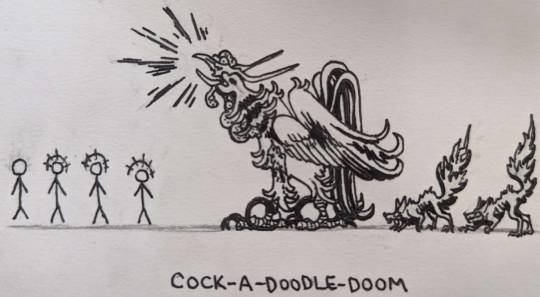
(Art by Vale!)
I had a dream last night about a new Darkest Dungeon 2 roving boss called the Cock-of-the-Walk, a gigantic mutated chicken that could appear to harass any party that entered a road battle without any food in their inventory. However, it'd make more sense as a miniboss or even alternate boss in the Foetor, replacing the Harvest Child or appearing in Resistance Encounters. The dream was fairly detailed with its behaviors and abilities, so I wrote it down in several discord servers to share with friends. When one actually drew the damn thing, I had to try my hand at statting it out.
So click below to see the boss stats for this thing
Base stats:
Max HP: 110
Speed: 10
Sz 1
1 turn/round
20% Bleed Resist / 60% Blight Resist / 20% Burn Resist
40% Stun Resist / 10% Move Resist / 40% Debuff Resist
20% Deathblow Resist
Attacks:
Fox in the Henhouse: Free action; always the first move used in battle; summons 3 Fierce Foxes, then moves CotW to rank 4.
Hunt and Peck: Usable in ranks 2, 3, and 4. Targets player ranks 3 or 2; crit rate 15%. Moves forward 1, deals 5~10 damage, attempts to daze the target and pull them forward 1. If the target has combo, they're paralyzed instead of dazed.
Chicken Scratch: Usable in all ranks. Targets player ranks 3, 2 or 1; if the target has combo, it also affects a random adjacent hero. Crit rate 10%, +10% vs combo. Moves forward 1, deals 4~8 damage and attempts to inflict a 3x3 bleed and pull the initial target forward 1.
Foul Fowl: Usable in ranks 2 and 3. Targets ranks 4, 3, and 2; crit rate 5%. Moves back 1, deals 3~6 damage and attempts to inflict a 3x3 blight; any targets with combo can be shuffled.
Cock-A-Doodle-Doom: Usable in rank 1. Targets ranks 3, 2, and 1; no crit rate. Clears ALL corpses and summons 1 Fierce Fox. Moves back 3, deals 6~16 damage, and attempts to inflict 1~3 stress to each affected hero.
-----
FIERCE FOXES
Max HP: 15
Speed: 3
Sz 1
1 turn/round
10% Bleed Resist / 35% Blight Resist / 10% Burn Resist
20% Stun Resist / 10% Move Resist / 20% Debuff Resist
No Deathblow Resist
Attacks:
Outfox: Usable from any rank. Targets any player rank; 10% crit rate. Deals 2~5 damage and attempts to inflict 1 of blind, daze, weak, vulnerable, or combo. Attempts to inflict a second negative token if it critically hits.
Over the Lazy Dog: Usable from rank 4. Targets rank 1; no crit rate. Moves forward 3, grants self a speed and dodge token. inflicts combo on the target.
Sly as a...: Usable from rank 1. Targets rank 1. Moves backwards 3, deals 3~7 damage, and transfers one of the target's positive tokens to the CotW. Consumes combo.
Give No Fox: Usable from any rank. Targets the CotW if it's adjacent to the Fox. Deals a flat 10 damage to the CotW, purges two negative tokens, and grants it two random positive tokens. Deals 0~1 stress damage to entire party. If a combo token is present on the CotW, it is removed and the CotW gains 3x5 regeneration.
Notes:
Killing the CotW causes it to drop a Delicious Chicken Dinner, a party-wide food item that restores 4 stress, 20% HP, and cures diseases. It grants a flat +10 max HP and +15% resist to ALL resistance stats until the next inn.
Full boss CotW drops one of two trophies: The Tended Flock, which increases party maximum HP by 20%, and disease and blight resist by 50% so long as there's no food in your inventory; and the Empty Nest, which increases food stacking by 6 per stack and causes more food to drop from any encounter which could drop it
If the CotW is instead killed by a Fierce Fox, the party takes 3 stress each and becomes afflicted by a +10% meltdown chance and a +10% chance to form negative relationships until the next inn. The party has special barks when Give No Fox is used to inform players that they should not allow it to die to the foxes. A Fox will attempt to use Give No Fox if the CotW began its turn with at least one negative token or a combo token (including and especially the ones it gains by entering Death's Door); the attack can miss if the Fox is blinded, or the CotW has a dodge token.
And yes the constant running around is like a chicken with its head cut off.
36 notes
·
View notes
Text

#AUtober (or #AUnytime) Prompt Challenge
30+1 Alternate Universe Art/Fic/Etc. genres for your OCs/Fandoms - organised for maximum reusability! Please check @autober ’s page for a text version of the list.
Officially #AUtober so it can be combined with other October challenges like Inktober, but feel free to do it #AUnytime! This list is usable for challenges of any sort - doodling, drawing, writing, or otherwise - and can be used in any way: do all, pick some, and/or combine at will.
Use the #AUtober tag (or #AUnytime outside of October) and tag @autober to be reblogged to the AUtober tumblr. Have fun!
#alternate universe#au prompt#drawtober#inktober#writing prompt#oc#art prompt#art challenge#artober#october art challenge#au#autober#info#october 2023
28 notes
·
View notes